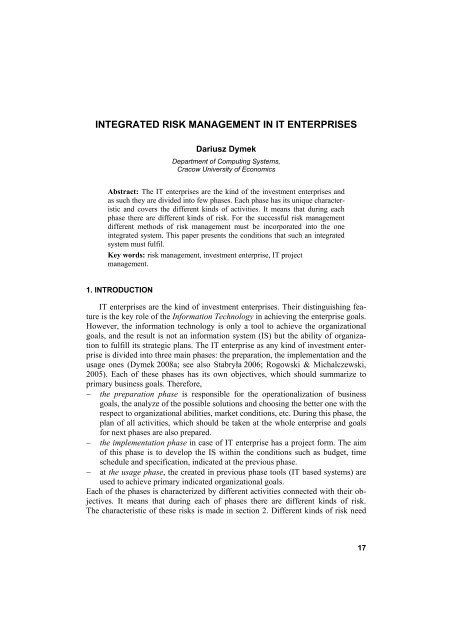INFORMATION SYSTEMS IN MANAGEMENT V - SGGW
INFORMATION SYSTEMS IN MANAGEMENT V - SGGW
INFORMATION SYSTEMS IN MANAGEMENT V - SGGW
Create successful ePaper yourself
Turn your PDF publications into a flip-book with our unique Google optimized e-Paper software.
<strong>IN</strong>TEGRATED RISK <strong>MANAGEMENT</strong> <strong>IN</strong> IT ENTERPRISES<br />
Dariusz Dymek<br />
Department of Computing Systems,<br />
Cracow University of Economics<br />
Abstract: The IT enterprises are the kind of the investment enterprises and<br />
as such they are divided into few phases. Each phase has its unique characteristic<br />
and covers the different kinds of activities. It means that during each<br />
phase there are different kinds of risk. For the successful risk management<br />
different methods of risk management must be incorporated into the one<br />
integrated system. This paper presents the conditions that such an integrated<br />
system must fulfil.<br />
Key words: risk management, investment enterprise, IT project<br />
management.<br />
1. <strong>IN</strong>TRODUCTION<br />
IT enterprises are the kind of investment enterprises. Their distinguishing feature<br />
is the key role of the Information Technology in achieving the enterprise goals.<br />
However, the information technology is only a tool to achieve the organizational<br />
goals, and the result is not an information system (IS) but the ability of organization<br />
to fulfill its strategic plans. The IT enterprise as any kind of investment enterprise<br />
is divided into three main phases: the preparation, the implementation and the<br />
usage ones (Dymek 2008a; see also Stabryła 2006; Rogowski & Michalczewski,<br />
2005). Each of these phases has its own objectives, which should summarize to<br />
primary business goals. Therefore,<br />
− the preparation phase is responsible for the operationalization of business<br />
goals, the analyze of the possible solutions and choosing the better one with the<br />
respect to organizational abilities, market conditions, etc. During this phase, the<br />
plan of all activities, which should be taken at the whole enterprise and goals<br />
for next phases are also prepared.<br />
− the implementation phase in case of IT enterprise has a project form. The aim<br />
of this phase is to develop the IS within the conditions such as budget, time<br />
schedule and specification, indicated at the previous phase.<br />
− at the usage phase, the created in previous phase tools (IT based systems) are<br />
used to achieve primary indicated organizational goals.<br />
Each of the phases is characterized by different activities connected with their objectives.<br />
It means that during each of phases there are different kinds of risk.<br />
The characteristic of these risks is made in section 2. Different kinds of risk need<br />
17


